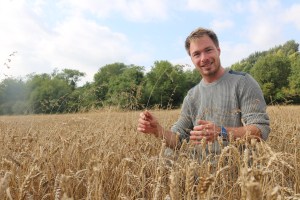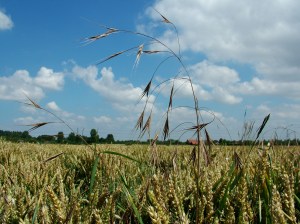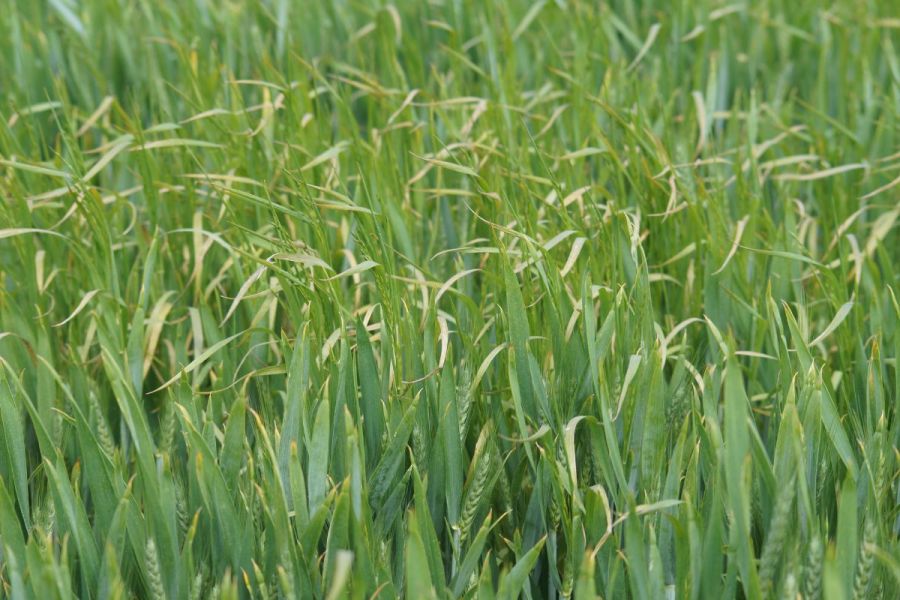The hot topic this season has undoubtedly been grassweeds and the challenge they’ve become. CPM collates some of the latest expertise to help reinforce the message that best practice will eventually prevail.
“There’s no better time to be talking about best practice than after a high pressure year.”
By Janine Adamson and Rob Jones
Looking for the positives – it’s often easier said than done, particularly when faced with a prolific grassweed problem which was previously under control. However, the message from experts is to keep the faith, after all, each year is different.

According to Will Smith, the key is to change focus – understand which specific weeds are in abundance and improve knowledge around their individual characteristics and behaviour.
NIAB’s Will Smith admits his summer has been spent talking about brome and high grassweed pressure, but says that’s because this is the ideal time to be opening up discussions. “There’s no better time to be talking about best practice than after a high pressure year.
“The key is to change focus – understand which specific weeds are in abundance and improve knowledge around their individual characteristics and behaviour,” he says.
For brome, which are increasing in occurrence, this can be complicated because they present as five main species. Barren (sterile) and great brome are often grouped together based on physical appearance, with meadow, rye and soft brome forming a second grouping. There can be confusion in the ID within these groups, says Will.
“We’ve seen more of the former group this year, in particular great brome, which is perhaps unusual,” comments Will. “For these species, the recommendation is to cultivate as soon as possible after harvest to prevent dormancy and create a flush. This season this might be tricky due to weather conditions and ground travel,” he says.
Because barren and great brome predominantly germinate in the winter, Will says switching to spring cropping is an appropriate control measure. However, the advice on cultural control is the opposite for meadow and rye brome. For this group, cultivation should be delayed for at least four weeks after harvest so the shed seed can ripen.
“We do observe a more significant spring cohort emerging than has been suggested, so spring cropping may be less effective, whilst also making control more difficult in autumn-sown crops,” comments Will.
Identifying the specific brome in question is crucial not only to inform cultural control methods, but for herbicide choice too. For example, trials conducted by ADAS indicate the efficacy of Tower (diflufenican+ pendimethalin+ chlorotoluron) varies depending on target species and timing of application, with each species of brome responding differently.

Bill Lankford says resistance to ALS-inhibiting herbicides has already been confirmed in UK brome populations.
Adama’s Dr Bill Lankford says the product offers activity against sterile, meadow and rye brome, as well as annual meadow grass and broadleaf weeds. This is important because resistance to ALS-inhibiting herbicides has already been confirmed in UK brome populations.
“Rye and sterile brome were shown to be the most susceptible to Tower when applied at the pre- or early post-emergence timings, whereas meadow brome is only susceptible when Tower is applied in combination with diflufenican at pre-emergence, or prosulfocarb from pre-emergence through to tillering.”
Additional trial work for Adama has shown that Falcon (propaquizafop) provides protection against four of the brome species, giving a 92-98% reduction in target populations of ALS-resistant barren, great, meadow and rye brome.
Will admits that although positive, nuanced trial data such as this can make active ingredient choice difficult. “It can be tricky to get things right due to the differences in the efficacy from residual chemistry. The high effectiveness of some actives against blackgrass (such as cinmethylin), doesn’t translate to brome, so you may be unwittingly creating gaps in your programme.”
He also says his mantra remains based on stacking cultural tactics. “Try to not focus solely on herbicides. You can’t top them up once they’ve been used within a season, therefore paying careful attention to each stage of decision making really does pay off.”
According to Will, some of this involves going back to the basics – maintaining a sterile edge between the field and the margin, selectively cultivating headlands to prevent ingress, and rotational plough use. “Unfortunately no-till favours brome, so remember it’s not a failure if you have to implement a plough reset,” he says.
He champions the added bonus of break crops and greater use of non-wheat options in the rotation. “This is an all-round win, so take advantage of the opportunity presented to control grassweed populations,” states Will.
In contrast to the brome discussions, for others, blackgrass remains front of mind. Hutchinsons’ Dick Neale says managing weeds is a ‘numbers game’, so even just a few surviving plants can soon have a dramatic impact on seed return and weed pressure in subsequent years.
“If a blackgrass head population is even noticeable in the field, it’ll generally be at around 100 heads/m2, so has the ability to deliver 10,000 seeds/m2 back to the soil. That amounts to one hundred million seeds/ha – the numbers are phenomenal.”
He explains trials suggest that 90% control of plants in the autumn only equates to 57% control of heads in the following May, because surviving plants are genetically stronger. “Single plants carrying 25 tillers are now becoming commonplace, compared with 9-10 tillers per plant 20 years ago. The goal posts are continually moving.”
This means preventing seed return should be the ultimate aim, and similar to Will, Dick says this requires an understanding of the types and species of weeds present in individual fields, their ecology, and resistance status.
Hutchinsons’ Cam Murray says when it comes to ryegrass, a powerful tactic is to leave fields for a good few weeks after harvest before tillage, because birds feed ‘veraciously’ on seed left on the ground. Seed resistance testing is also highly recommended.
“Italian ryegrass can develop true resistance to residual herbicides, therefore it’s important to understand which herbicides are effective on your specific weed population. Because resistance status varies from field to field, multiple tests may be required,” he says. “If you don’t know what you’re fighting, how can you possibly apply the correct chemistry?”
This sentiment is echoed by Will who says now is the time to know your enemy. “NIAB has been collecting brome samples this harvest in order to conduct resistance testing; for those with ALS resistance, this is acute.
“It’s easy to approach this season from a negative perspective, and understandably so. But here we have the opportunity to share knowledge and look at what’s possible moving forward,” he concludes.
Understanding modes of action

Longevity, solubility and uptake mechanism can all affect the performance of herbicides in different conditions, says Paul Fogg.
Whereas alternating modes of action may have been formerly viewed as a tactic for fungicide management, using a similar approach for weed control seems to be gaining more momentum.
A recent mode of action survey conducted by Bayer highlights that farmers are aware of the importance of herbicide stewardship, and carefully consider how they use the chemistry available.
Bayer’s herbicide manager, Tom Chillcott, says the survey results are encouraging. “In general, I think farmers are aware they require a strategy to protect different modes of action and are starting to do so, but would perhaps like more information and support to achieve the best results.”

Tom Chilcott says different active ingredients are suited to certain weeds, whereas conditions also play a huge role.
In the survey, 55% of participants reported dealing with grassweed resistance, either pre- or post-em. 83% stated resistance management was very important to agronomy on-farm, backed by 75% of participants who use three or more modes of action in their wheat herbicide programme.
Importantly, all survey participants indicated that they’re taking at least one step to protect herbicide modes of action from resistance.
Tom says moving into autumn, Bayer’s aim is to share information about using different modes of action to help farmers refine their herbicide programmes. “For instance, different actives are particularly suited to certain weeds whereas conditions also play a huge role – last autumn seedbeds were dry and Proclus (aclonifen) is less affected by this than many other options,” he says.
“This season, there’ll most likely be more soil moisture which promotes flufenacet performance, but it also makes farmers more nervous about drilling date and available spray windows.”
In terms of specific weeds, the survey suggests bromes and wild oats are considered more of a challenge than Italian ryegrass. “For this, participants could pick up to three weeds from a list. Given that bromes and wild oats are more common across the whole arable area, it’s not surprising that they’re high on the survey, whereas ryegrass is still concentrated in certain areas where it can be very difficult to control,” explains Tom.
“Controlling brome is something we hear more farmers discussing. Meadow brome and rye brome both tend to germinate in late autumn and into the winter, so relying on delayed drilling doesn’t work. Residual herbicides should be topped up in November to provide longer protection.”
IPM integration
“I describe IPM as understanding the agro-ecology of the enemy,” says Frontier’s Dr Paul Fogg. “For grassweed control it all goes back to managing seed return, to reduce the weed burden in future seasons.”
He explains that a considered approach to chemical weed control is required and although a range of actives are at a grower’s disposal, responsible use is essential in terms of resistance management, stewardship and to prolong the future of the crop protection armoury.
Paul believes despite chemistry being part of the solution, it’s best to view it as ‘the icing on the cake’ after cultural control methods such as cultivation, rotation and drilling date have been explored.
He says at present, farmers are in a good position at the pre- to early post-em timing in autumn with a wide range of actives to choose from in wheat, and to some extent, barley.
“Importantly, the actives come from a range of HRAC Mode of Action groups so there’s good potential to have effective and durable herbicide programmes. In contrast, contact-acting chemistry is mostly only one mode of action – ALS-Inhibitors (HRAC Group 2).
“Mode of action diversity has always been a consideration for resistance management, but we’re now starting to pay more attention to it. In the past, farmers perhaps wouldn’t have known where to look but now the HRAC Group should be included on all product containers and labels,” explains Paul.
Understanding the nuances of an individual farm includes resistance testing to confirm the correct chemistry is being used. In addition to the mode of action, the physical and chemical characteristics of the herbicide should also be considered.
“Longevity, solubility and uptake mechanism can all affect the performance of herbicides in different conditions,” notes Paul.

Managing weeds can be a ‘numbers game’ – even a few surviving plants have a dramatic impact on seed return and weed pressure in subsequent years.
“Applying products appropriate to the conditions is important. If the weather goes against you and application is delayed, metribuzin applied with flufenacet and diflufenican seems to bring efficacy at the early post-em timing and has efficacy against broadleaf weeds like groundsel,” he says.
When planning herbicide strategies, Paul recommends using a pyramid approach. “The base is glyphosate – a fundamental active, without which, sustainable weed control in many arable situations would be difficult. On top of that are the foundation actives – flufenacet, cinmethylin and increasingly tri-allate; you build the strategy around one of these actives.”
Completing the triangle are partner products such as diflufenican, aclonifen, pendimethalin and metribuzin. Paul says stacking actives is important to try and overcome complex resistance mechanisms that may be present in the population.
“For these herbicides, we have to make sure we’re applying an effective dose of our foundation actives, but then look to improve control by adding others. There’s been a tendency to chase control with high-rates of flufenacet, but you see diminishing returns and it’s a huge resistance risk.”
Paul believes the importance of stewardship, particularly achieving the correct dosage for effective control, was demonstrated with glyphosate.
“In a stale seedbed situation, target a minimum of 540g/ha at 1-2 leaf stage of blackgrass and increase the dose accordingly as the size of the target increases. Sub-optimal dosing is the thin end of the wedge for resistance development.
“This highlights the importance of ensuring any survivors of the first spray application are removed mechanically before making follow-up applications,” he concludes.
This article was taken from the latest issue of CPM. For more articles like this, subscribe here.
Sign up for Crop Production Magazine’s FREE e-newsletter here.




